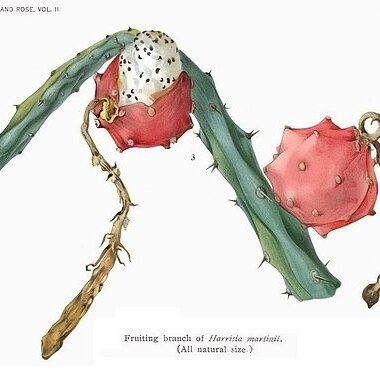Sprawling or clambering shrub, capable of resprouting from an underground rootstock, c. 0.8(-2) m tall; stems much-branched, often arching; branches dark green, (1.5-)2-2.5(-4) cm in diameter, not rooting aerially; ribs 4-5, low, lending the stems an appearance of plaited rope; areoles seated on broad tubercle, 1.5-2.5(-3.5) cm apart. Central spine 1(-2), 2-3(-4) cm long; peripheral spines 1-3 (-7), up to 3 mm long. Flowers nocturnal, from Nov. to Mar., 15-22 x 15-17 cm; scales broadly triangular-subulate, 2-3 mm long; pericarpel areoles felted and more or less hairy; outer tepals narrow, greenish white; inner tepals white or pale pink. Fruit from Dec. to May, globose, c. 3 cm in diameter, tuberculate and very shortly spiny, red, splitting down one side; pulp white. Seed black-brown (virtually black).
Sprawling or clambering shrub, resprouting from an underground rootstock, up to 3 m high; stems much branched, often arching; branches dark green, 20-25 mm in diameter, 4-or 5-ribbed, lending the stems an appearance of plaited rope; areoles seated on broad tubercles. Spines in groups with 1 or 2 central spines longer than peripheral spines. Flowers nocturnal; 15-22 mm long; floral tube areoles felted and ± hairy; outer perianth segments narrow, greenish white; inner perianth segments white or pale pink; Nov.-Mar. Fruit globose, 30 mm in diameter, tuberculate and very shortly spiny, red, splitting down one side; pulp white.
Plants with tuberous roots and long, fairly supple, clambering, much branched stems, 1-2 cm in diam., 4-5-angled; areoles numerous, placed fairly close together, raised and shortly pubescent bearing a stout central, patent or reflexed spine up to 3 cm long and several very short radiating spines. Flower about 20 cm long; outer segments linear, greenish; inner broader, white or pinkish. Fruit globose, 3.5 cm in diam., red, with small scales, the withered perianth long persistent; seeds small, black, scattered in a white pulp.
Plant much branched, clambering, up to 2 m long. Stems green to grey-green, 20-25 mm in diam.; young stems pointed, 4-or 5-angled; older stems round in cross section, spineless. Spines: central spine single, stout, yellowish with dark tip, 20-30 mm long; radial spines 5-7, short. Flowers up to 200 mm long; pericarpels with scales and brown wool. Fruit red, 35 mm long with scales and spines.
A cactus.


